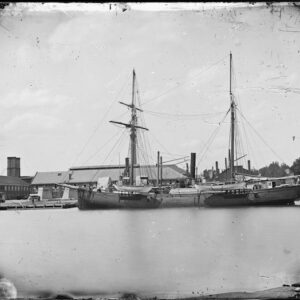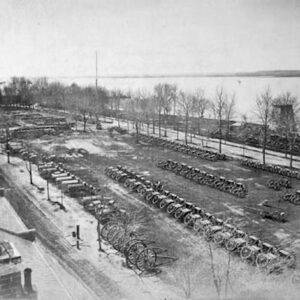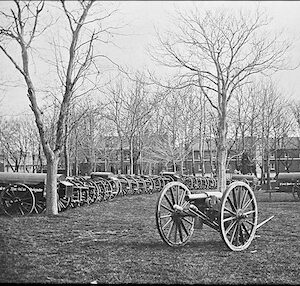Tag: Washington Arsenal (Washington DC)
Wikipedia says: Fort Lesley J. McNair is a United States Army post located on the tip of Greenleaf Point, the peninsula that lies at the confluence of the Potomac River and the Anacostia River in Washington, D.C. To the peninsula’s west is the Washington Channel, while the Anacostia River is on its south side. Originally named Washington Arsenal, the fort has been an army post for more than 200 years, third in length of service, after the United States Military Academy at West Point and the Carlisle Barracks.
The military reservation was established in 1791, on about 28 acres (110,000 m2) at the tip of Greenleaf Point. Major Pierre Charles L’Enfant included it in his plans for Washington, the Federal City, as a significant site for the capital defense. On L’Enfant’s orders, Andre Villard, a French follower of Marquis de Lafayette, placed a one-gun battery on the site. In 1795, the site became one of the first two United States arsenals.
An arsenal first occupied the site, and defenses were built in 1794. However, the fortifications did not halt the invasion of British forces in 1814, who burned down many public government buildings in Washington, D.C., during the War of 1812. Soldiers at the arsenal evacuated north with as much gunpowder as they could carry, hiding the rest in a well as the British soldiers came up the Potomac River after burning the Capitol. About 47 British soldiers found the powder magazines they had come to destroy empty. Someone threw a match into the well, and “a tremendous explosion ensued,” a doctor at the scene reported, “whereby the officers and about 30 of the men were killed and the rest most shockingly mangled.”
The remaining soldiers destroyed the arsenal buildings, but the facilities were rebuilt from 1815 to 1821. Eight buildings were arranged around a quadrangle and named the Washington Arsenal. In the early 1830s, four acres of marshland were reclaimed and added to the arsenal. A seawall and additional buildings were constructed. Between 1825 and 1831, the penitentiary was constructed on the arsenal with a three-story block of cells, administrative buildings, and a shoe factory for teaching prisoners a trade. In 1857, the federal government purchased additional land for the site. By 1860, the arsenal had used one of the first steam presses, developed the first automatic machine for manufacturing percussive caps, and experimented with the Hale Rocket. A large civilian workforce manufactured ammunition at the arsenal, and the site included a large military hospital.
Explosion
During the Civil War, women worked in an ammunition factory at the Washington Arsenal. Many lower-class women—including Irish immigrants—needed wages, especially after male relatives went to war. Women were believed to have nimble fingers, attention to detail, and a tendency to neatness suitable for rolling, pinching, tying, and bundling cartridges with bullets and black powder.
On June 17, 1864, fireworks left in the sun outside a cartridge room ignited, killing twenty-one women, many of whom burned to death in flammable hoop skirts. The War Department paid for their funerals, and President Lincoln attended the joint funeral procession. A monument at Congressional Cemetery commemorates these women. In memory of the many Irish victims, the Irish foreign minister laid a wreath at Congressional Cemetery memorial during 150th anniversary commemorations in 2014.
Lincoln conspirators’ trial
The conspirators accused of assassinating president Abraham Lincoln were imprisoned on the grounds of the arsenal, tried by military commission. After being found guilty, four were hanged on the premises, and the rest received prison sentences. Among those hanged at what would become Fort McNair was Mary Surratt, the first woman ever executed under federal orders.
One of the buildings on the complex, Ulysses S. Grant Hall, is the location of the 1865 military tribunal of the conspirators of the assassination of Abraham Lincoln. The hall periodically holds public open houses. Each quarter of the hall is open to the public, and people can visit the courtroom and learn more about the trials. A hospital was built next to the penitentiary in 1857. Wounded Civil War soldiers were treated at what then was called the Washington Arsenal. The arsenal was closed in 1881, and the post was transferred to the Quartermaster Corps.
Showing 1–16 of 36 resultsSorted by latest
-

Image ID: AZMO
$1.99 -

Image ID: APQL
$6.99 -

Image ID: APQK
$6.99 -

Image ID: APWP
$6.99 -

Image ID: ASNK
$6.99 -

Image ID: ASPM
$6.99 -

Image ID: APED
$4.99 -

Image ID: AMBD
$0.99 -

Image ID: AMBP
$6.99 -

Image ID: AMCT
-

Image ID: AQPX
$6.99 -

Image ID: AQLX
$6.99 -

Image ID: ARDU
$6.99 -

Image ID: AJZZ
$6.99 -

Image ID: AKAA
$6.99 -

Image ID: ACVI
$1.99